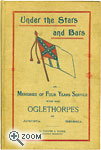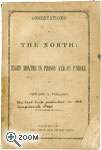ON THE MARKET
Collecting Civil War Books
The Civil War is the defining event in the history of
America. It tore the country in two and rebuilt it without the stain of
slavery. It also took place at a turning point in the history of warfare.
As Douglas O’Dell of Chapel Hill Rare Books explained,
“Although modern weaponry had rapidly evolved [exploding shells, repeating
rifles], Napoleonic tactics [full frontal assaults] were still in common
use.” As a result, individual acts of heroism by common soldiers were
routine. “The Civil War was probably the last romantic war in our
history,” he said.
The war also occurred at a time when new printing
technologies mass-produced literature for the entire nation. It became the
most documented war in history up to that time, covered extensively in newspapers,
magazines, government reports, histories, memoirs, and even private diaries
and letters of figures both famous and ordinary, whose lives were transformed
by war and its aftermath. The sheer volume of Civil War literature is overwhelming,
yet flush with collecting opportunities.
|
$950
Four years in the Confederate army |
Top among them is Lincolnia. “Lincoln literature
is out there in abundance for the collector—fortunately and unfortunately,” Daniel
Weinberg, who runs the Abraham
Lincoln Bookshop in Chicago, said. “The real problem
is that the public appreciates too many things just because they are old
or because it’s Lincoln.” For the discerning collector, there
are several avenues to pursue: signed letters, documents, and photographs;
assassination pamphlets; and campaign biographies and speeches.
Lincoln didn’t live long enough to write
his memoirs, but many Union and Confederate generals and officers did. Grant’s Personal
Memoirs, edited by Mark Twain while the former president lay dying
of cancer, is the landmark. Fine copies command prices in the low four figures,
and collectors should be wary of inexperienced dealers offering signed first
editions. Every copy bears a facsimile of Grant’s signature, but signed
books are an impossibility. He was dead before the book ever saw print.
Among the Confederate generals, there is a dearth
of first-hand accounts by its leading lights. Robert E. Lee, Jeb Stuart,
and Thomas “Stonewall” Jackson wrote little more than military
orders and correspondence. Lee’s General Order Number Nine, announcing
the Confederate surrender, is one of the most prized pieces of Americana.
Several signed copies of the document have appeared at auction in the last
ten years, fetching prices in the $100,000 range. Joe
Rubinfine, an autograph and manuscript dealer in Florida, cautions
that it’s tough to find any signed or significant material by these
generals for under four figures.
In a more moderate price range are the unpublished
letters and manuscripts of soldiers who fought the war. A signal example
from Rubinfine’s stock is the diary of Confederate solider John Worting,
who fought in the battles of Winchester, Cedar Mountain, and Second Manassas,
where he lost an arm, yet he continued to take notes. Selling for $7,500,
the diary is lovingly preserved in a box and comes with additional histories
and notes assembled by a previous collector.
“Obviously commentary on major battles, officers, etc. would be desirable,” advises
Rubinfine, “rather than (particularly on letters sent home) what I
like to call ‘How’s the cow?’” Condition of manuscripts
should be carefully evaluated, but for Rubinfine legibility is most important. “I
don’t like to work too much” when reading, he said. next >






